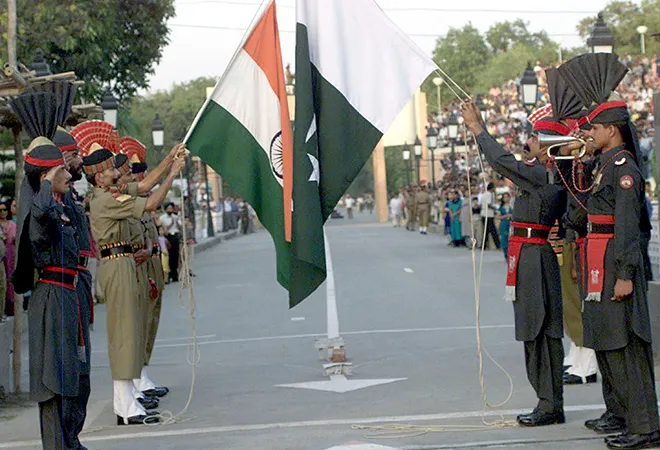
Unless something really dramatic or drastic takes place, the first year of the second decade, and maybe even the better part of the coming decade of the 21st Century, is unlikely to see anything positive happening between India and Pakistan. If anything, the odds in favour of things becoming worse are much higher than those in favour of things improving. It will be something of an achievement if even the current state of extreme tension is maintained and not allowed to escalate.
2019 has in many ways set the tone, tenor and tempo of how 2020 and perhaps the 2020’s will pan out between India and Pakistan. Early in the year, the Pulwama suicide bombing carried out by a Pakistani terrorist group Jaish-e-Mohammad (JeM) killing over 40 CRPF personnel was the starting point of the steep slide in relations. Within a few days, India shook off the restraints it has imposed on itself for more than three decades, and fighter jets targeted a JeM terrorist camp, not in Pakistan-occupied Kashmir but in Balakot in the Pakistani province of Khyber Pakhtunkhwa. Within a day, the Pakistanis retaliated and at one point it seemed that the two countries were on the brink of an all-out war, what with reports that India was planning missile strikes on multiple targets inside Pakistan, and the Pakistanis warning that they would respond in a similar manner.
Although both sides pulled back from the brink of war, the entire episode seemed to indicate that India’s cup of patience with Pakistani sponsored terrorism was now filled to the brim. It also delivered a message that Pakistan no longer enjoys the impunity it thought it did and that India would now hit back without caring too much about the nuclear umbrella under which Pakistan merrily sent terrorists into India. Effectively, this new Indian template for dealing with cross-border terrorism seems to have injected ambiguity and uncertainty in the stand-off between India and Pakistan. The latter can no longer be sure about how India would react if Pakistani sponsored terrorists crossed the threshold of tolerance.
Even as the two sides were adjusting to the new paradigm that was unfolding, India went into elections in which the Narendra Modi led BJP was re-elected with an increased margin. Some credit for this victory was laid at the door of the resolute action taken by the Modi government against Pakistan. In a way, this set a sort of standard against which every government in India will be measured. Going forward, it will be political suicide for any government to not be seen responding militarily to any grave provocation from Pakistan.
The second monumental change that happened in August also shook Islamabad. The amendment and hollowing out of Article 370, scrapping of Article 35A, the bifurcation of the erstwhile state of Jammu and Kashmir into two Union Territories stunned Pakistan. While the sheer audacity of the move was breathtaking, it effectively killed whatever remained of the bilateral relationship after Balakot. Pakistan reacted with predictable hysterics, screaming and shouting about how India was preparing for a bloodbath in Kashmir, how millions of people will be streaming into Pakistan, how demographic invasion and genocide would be unleashed.
In a typical knee-jerk reaction, Prime Minister Imran Khan downgraded diplomatic relations by expelling the Indian High Commissioner and suspending all trade between the two countries. Trade in any case had fallen steeply after India withdrew the MFN status and imposed 200% import duty on Pakistani goods. However, within days Imran Khan had to relax the trade ban after the Pakistanis realised they desperately needed medicines from India. Even so, after the Kashmir move, all that remains is a diplomatic presence in either country but virtually zero diplomatic communications or contact on the face of it.
In the midst of the post Article 370 breakdown, Pakistan went ahead with the Kartarpur corridor. While the eternal optimists have seen this Pakistani ‘initiative’ with rose-tinted glasses, the realists believe that Pakistani intentions are not noble and they are trying to use Kartarpur to re-ignite the Khalistani movement. Therefore, the one thing which could be called positive also has no traction because of the deep suspicions and mistrust that underscore the bilateral relationship.
This is the backdrop against which India and Pakistan will enter 2020. The bilateral relationship which has become very bitter and prone to brinkmanship (which could lead to miscalculation and/or accidents) is only one part of the problem. The rising complexity in the regional dynamics will also complicate the India-Pakistan equation. At the bilateral level, as long as Imran Khan remains at the helm in Pakistan, the well will continue to be poisoned by his vile and bordering on deranged rants against his Indian counterpart. But even if he is replaced, his successor isn’t likely to resile from the strident stand that Imran Khan has taken on India, which is extremely popular not just in the military, but also with the Mullahs, Mujahideen, media and even the people. As for Imran himself, given that he is not exactly a very bright person – he often parrots the last thing someone whispers in his ears – nothing much can be expected from him, unless of course he takes one of his well-known U-turns on Modi and India. But for that to happen, he will have to get the nod, or the push, from his bosses – the men in Khaki in the Pakistan Army – which seems unlikely.
Even if the churn in the Pakistan army over the extension of the current chief, Gen. Qamar Bajwa, settles, chances are that whether it is Bajwa or his successor, both will double down on the hostility against India. The excuse for this will of course be Kashmir, where a spike in terrorism is on the cards. Nevertheless, added to Kashmir will be the Pakistanis arrogating to themselves the role of ‘fortress of Islam’ especially in relation to Muslims of the subcontinent. It is almost a given that Pakistan will not just make every effort to re-ignite separatism in Punjab – Referendum 2020 for instance – but also do everything possible to incite and instigate Indian Muslims – another Indian Mujahideen type of terror outfit could be raised to give things an indigenous flavour and retain plausible deniability.
The entire CAA-NRC-NPR issue will be milked by Pakistan not just to create trouble in India but also forward its poisonous propaganda campaign against India in international fora. Rest assured that Pakistan would use every available forum – from animal husbandry to climate change– to ‘raise’ the Kashmir issue. Alongside, Pakistan will insidiously use dissident Indian voices (minorities in particular) to lend credibility, even legitimacy, to its campaign against India. Clearly, all this is hardly going to pave the way for any sort of re-engagement between the two countries.
The regional strategic environment is also not going to be very conducive for the India-Pakistan dynamic. The endgame in Afghanistan will probably see greater contestation between the two countries, in addition to new alignments. The China factor will continue to loom over South Asia, not just in the context of CPEC but also the Indo-Pacific strategy. The more India hedges China by engaging in the Indo-Pacific with the US and its allies, the more Beijing will rely on Pakistan to keep India unsettled. Even if India doesn’t play ball on Indo-Pacific, the Chinese are unlikely to stop leaning heavily in propping up Pakistan against India, regionally and globally. The US too will use Pakistan to focus India’s attention on itself and its Indo-Pacific strategy.
The Russians are already opening up to Pakistan, and 2020 will further determine the depth and heft in this budding relationship, with obvious consequences for India as Pakistan will feel further emboldened. The one area in which India had a big advantage over Pakistan – economy – has also lost its lustre. While Pakistan’s economy is unlikely to come out of the ICU in 2020, the danger is that India might be heading into the ICU. In that event, India will be more susceptible to some pulls and pressures and its ability to squeeze Pakistan will be constrained. As for SAARC, it will most likely remain confined to the cold storage, unless of course the next summit is shifted out of Pakistan.
All in all, the prospects for any meaningful engagement between India and Pakistan remain very bleak. While Mr Modi has been known to take U-turns in the past on Pakistan, given the sort of invective hurled against him by Pakistani leaders, especially Imran Khan, he will not have much appetite to reach out, unless of course he is ready to capitulate, i.e. restores Article 370, withdraws CAA, abjures NRC, none of which seem to be even remotely possible. In Pakistan, even if there is a new dispensation, the fundamental dynamics defining the bilateral relationship are not going to change.
Therefore, even if someone is given to flights of fancy, the best that can happen on the India-Pakistan front is that diplomatic relations are restored fully, trade opens up, there is some easing up on travel. Beyond that, the sniping and insidious policies will continue, the LoC in Kashmir will remain hot, Pakistani export of terrorism will remain a problem but will probably remain below the threshold of tolerance. In other words, yesterday once more.
The views expressed above belong to the author(s). ORF research and analyses now available on Telegram! Click here to access our curated content — blogs, longforms and interviews.




 PREV
PREV


